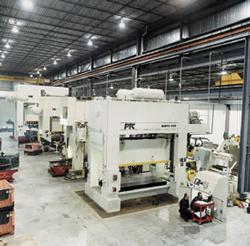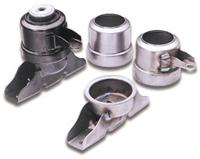President
- FMA
- The Fabricator
- FABTECH
- Canadian Metalworking
Categories
- Additive Manufacturing
- Aluminum Welding
- Arc Welding
- Assembly and Joining
- Automation and Robotics
- Bending and Forming
- Consumables
- Cutting and Weld Prep
- Electric Vehicles
- En Español
- Finishing
- Hydroforming
- Laser Cutting
- Laser Welding
- Machining
- Manufacturing Software
- Materials Handling
- Metals/Materials
- Oxyfuel Cutting
- Plasma Cutting
- Power Tools
- Punching and Other Holemaking
- Roll Forming
- Safety
- Sawing
- Shearing
- Shop Management
- Testing and Measuring
- Tube and Pipe Fabrication
- Tube and Pipe Production
- Waterjet Cutting
Industry Directory
Webcasts
Podcasts
FAB 40
Advertise
Subscribe
Account Login
Search
Contract stamper increases die life and draw die productivity
Link-drive presses, value-added services, and employee initiative keep the company competitive
- By Heinz Becker
- November 15, 2001
- Article
- Bending and Forming
Jancox Stampings has remained competitive by investing in link drive mechanical presses from PTC, offering value-added assembly services, and encouraging employee initiatives. The article discusses how the presses work and how reduced speed reduces springback (which allows the company to meet the tight tolerances its company requests). It also covers the company's assembly operations and need for employees who can make the most of its equipment.
Manufacturers whose products contain formed metal parts have a lot of money tied up in stamping dies, especially complex tooling such as draw dies. A contract stamper that can get the most from its die investment, while delivering consistently high-quality parts competitively, stands to gain business. That's what Brampton, Ontario-based Jancox Stampings has found.
Jancox Stampings is a QS-9000- and ISO 9002-certified business. The privately owned company employs more than 70 people and processes more than 15 million pounds of steel annually in its 85,000-sq.-ft. Brampton plant. The company is a components producer and contract stamper primarily for automotive and transportation industry OEMs and Tier 1 suppliers.
To remain competitive, the company set out to update its equipment by investing in link-drive mechanical presses for deep-draw and other applications; perform additional assembly operations; and encourage its employees to learn multiple skills.
Using the link-drive mechanical presses for deep drawing and other applications has doubled die life while achieving throughput-enhancing increases in press speeds. Also, die maintenance costs have been reduced by 40 percent compared to the crank presses used previously.
How a Link-drive Press Works
The company performs progressive die draw work primarily on two of its three link presses—600- and 800-ton PTC combination link presses that also do blanking and coining (see Figure 1).
It also uses a 400-ton PTC blanking link press, which has a shorter (14-in.) stroke. This press is suitable for heavy blanking, forming, coining, and heavy progressive die and transfer work (see Figure 2).
A link-drive press's main advantage has to do with the ram's motion. During the work stroke (the bottom of the stroke), slide velocity is reduced by as much as 50 percent, allowing metal forming to occur more slowly and with less heat buildup.
The ram's fast speed during its approach and return compensates for the slower work stroke. The optimized kinematics of the link design can result simultaneously in higher speeds, better-quality parts, and longer tool life.
This forming stroke works well for the deep-drawn motor mounts and other cup-style parts that are a significant portion of the stamping mix at Jancox. Whereas speeds on the company's crank-driven presses range from 25 to 30 strokes per minute (SPM), their link presses average 35 to 40 SPM.
Reduced Speed Reduces Springback
The reduced speed during the work stroke allows time for extended metal flow, so less material springback occurs. Jancox has found that it can achieve excellent part surface finishes using link-drive presses, according to Jack Crepnjak, production supervisor.
"One of our parts requires a 54-mm draw and has two different diameters," Crepnjak says. "The height tolerance is ±0.002 in. Sometimes the lot-to-lot variance in steel stock can cause a 0.002- to 0.003-in. tolerance fluctuation in the drawn part, so the link press's ability to stretch the material at slower speeds to meet the tight tolerance is important."
The link presses also are suitable for shallow parts. One such part is a seat track for a sport utility vehicle. The company stamps 0.170-in.-thick, high-strength steel to make the part on the 800-ton link press using a 14-station, two-up progressive die. Two of the part's 90-degree bends must be held to ±0.5 degree.
The company also has found that the wear life of die surfaces and components such as draw cushions is longer because factors such as noise, heat, shock, and vibration are reduced.
Customers Like Additional Assembly Operations
Remaining competitive requires more than just increasing die life and improving press speed. About 70 percent of Jancox's jobs involve additional assembly operations before the company ships parts to the customer.
More than a dozen welding stations for either five-axis robotic gas metal arc welding (GMAW) or manual resistance welding are used to join components to make parts such as brackets (for engine mounts, air cleaners, or windshield washer bottles); transmission subframes; and other chassis, suspension, or under-the-hood components (see Figure 3).
Sebastijan Zupanec, plant manager at Jancox, said, "Our customer focus has paid off. The trend is toward a parts supplier supplying more value-added processes and services, and delivering a more complete component to the Tier 1 or automotive original equipment manufacturer."When one supplier can do all the work in-house, it's easier to deliver accountability in terms of part quality and ensure production deliverables," he said. "So, going beyond stamping to include assembly operations has been a logical extension of our capability."
As expected for an automotive supplier, just-in-time (JIT) is a way of life at Jancox. Although lot sizes typically are 10,000 to 50,000, the company must maintain some part inventories of only 1,000 per week.
Tighter lead-times on new projects, coupled with strict tryout and verification procedures, place additional demands on the company. In-house engineering, toolmaking, quality control, and die maintenance capabilities at Jancox help it to meet these timing requirements.Given the quantity of progressive die stamping it performs, most of Jancox's presses are coil-fed. Crepnjak said, "We'll be doing more blanking work in the future and also doing more hand-operated forming for these same parts on our smaller presses.
"Because maximizing scrap savings has a lot to do with making the job profitable, the progressive die process isn't always best. And our new 400-ton press will give us extra versatility — changing over from blanking to draw work, progressive or transfer die operations, or coil- to hand-fed applications."
The link-drive presses and an older crank-driven press have large bolster sizes, up to 180 by 72 in. This fits in well with the company's growth direction of producing larger and more complex parts.
Motivated Employees Integral to Success
While the stamper's machinery choices and services offered play important roles in growing the business, the value of its employees is paramount. A philosophy of encouraging multiple skills and initiative from all employees has served the company well.
Zupanec said, "Our people's skill level and internal drive toward making Jancox a success really make a big difference when it comes to today's sophisticated presses. You've got sensing and monitoring equipment, versatile controls, and also the process flexibility of the link-drive presses with ability to tweak the speed.
"It's all great, but if it's not working right, you can have a million-dollar tool sitting there without ever getting the full potential value from it."
About the Author
subscribe now

The Fabricator is North America's leading magazine for the metal forming and fabricating industry. The magazine delivers the news, technical articles, and case histories that enable fabricators to do their jobs more efficiently. The Fabricator has served the industry since 1970.
start your free subscription- Stay connected from anywhere

Easily access valuable industry resources now with full access to the digital edition of The Fabricator.

Easily access valuable industry resources now with full access to the digital edition of The Welder.

Easily access valuable industry resources now with full access to the digital edition of The Tube and Pipe Journal.
- Podcasting
- Podcast:
- The Fabricator Podcast
- Published:
- 04/16/2024
- Running Time:
- 63:29
In this episode of The Fabricator Podcast, Caleb Chamberlain, co-founder and CEO of OSH Cut, discusses his company’s...
- Trending Articles
How to set a press brake backgauge manually

Capturing, recording equipment inspection data for FMEA

Tips for creating sheet metal tubes with perforations

Are two heads better than one in fiber laser cutting?

Hypertherm Associates implements Rapyuta Robotics AMRs in warehouse

- Industry Events
16th Annual Safety Conference
- April 30 - May 1, 2024
- Elgin,
Pipe and Tube Conference
- May 21 - 22, 2024
- Omaha, NE
World-Class Roll Forming Workshop
- June 5 - 6, 2024
- Louisville, KY
Advanced Laser Application Workshop
- June 25 - 27, 2024
- Novi, MI






























